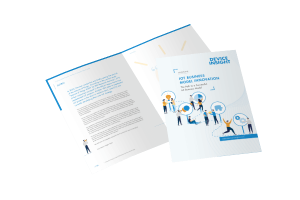“Agile” is currently THE buzzword, but not many companies know much about agility and related terms such as Kanban or Scrum. Here you can read which terms you should be familiar with within the Agile cosmos.

Many German companies are very well positioned in their field and often have the necessary innovative strength to survive in international competition. In order to remain competitive in the future, they must be able to react more flexibly to new market conditions. Shorter development cycles and a more volatile market environment, characterized by digitization, place new demands on a company’s work.
This insight is hidden in the very core behind the term agility. Agility requires not only rethinking and a changed corporate culture, but also new tools and methods. Such methodologies also include other terms which, like agility itself, are often in need of explanation, especially since they are mostly in English.
Essentially, agility means vital or energetic. In an economic or entrepreneurial context, however, the term refers to agile, mobile or flexible management and has its origin – such as Scrum, Kanban or Design Thinking – in product and software development.
The goal of many companies is to extend the principle of agility to other areas. Many managers and employees feel overwhelmed when roles are suddenly changed or softened, when some are supposed to give up their “power”, others their safety and comfort. Many already feel overwhelmed by the terms themselves. That’s why we’ve prepared an Agile ABC:
The agile goach does not – unlike a management consultant – show employees solutions, but rather how they can develop solutions themselves. In addition, the coach ensures that agile principles and methods are adhered to in daily work. An agile coach may be called in externally but can also work from with the company ranks. This can be of great advantage when it comes to designing concrete solutions. In other words, the agile coach is not a solution provider, but rather indicates possible solutions through observation and reflection.
A central feature of an agile organization is to break down classic thinking into departments and hierarchies and instead – depending on the project – to organize itself into different, largely independent and autonomous teams. Following the Spotify model, different agile organizational structures can be distinguished:
The squad is the smallest unit that is usually responsible for a customer or a customer project. A chapter groups the employees of a function together, whereby the chapter Lead, as technical leader, is responsible for the transfer of know-how, experience and skills. A tribe consists of several squads dedicated to a common universal product or service or whose work is closely related to each another. Guilds are groups of different team members who meet regularly to work together on specific universal solutions or competencies.
Design Thinking aims at creative work with a strict user focus and relies on a multidisciplinary, versatile team as well as a flexible room concept with plenty of space for high tables, whiteboards and materials. Among other things, this involves using prototypes to determine how products and solutions are received by customers.
Kanban is Sino-Japanese for “display board” and describes a method developed by Toyota in 1947 to better organize material flow in production according to the supermarket principle, essentially using Post-Its placed on a board. Each sticky note represents a task which is intended to make the division of labor more transparent and efficient. Nowadays, Kanban boards are no longer created on whiteboards, but usually using digital tools.
Product owner is the product or project manager in a squad. They represent the interface between business, user experience and technology and are the main point of contact for all project delivery issues to the customer as well as internally within the company.
Scrum was developed as a process model for agile software development and divides the project duration into stages or “sprints”. At the end of each so-called development step, the team must be able to present the customer with a functional intermediate product or result. The customer then gives feedback on how to initiate the next sprint. Compliance with this process is ensured by the scrum master.
To complete the anglicisms around agility, there are also sprints and daily stand-ups. The latter are more or less synonymous with daily scrum meetings, which are usually limited to 15 minutes and – to keep the meeting short – are held standing up. These meetings are designed to make product development teams more productive and efficient. Sprints are regular, repetitive workflows – also called Iterations – and have the goal of producing a product increment or functional intermediate product in the scrum team. Originally set at 30 days, such sprints are nowadays usually limited to one or two weeks. This ensures that the scrum team does not get lost in the details but concentrates on the basic functionality of the intermediate product.

In our guide, we accompany you step by step on the way to a successful IoT business model.


Delivering excellence in IoT. We are an IoT Solution Provider for Smart Products, Connected Vehicles, Smart City, Smart Energy and Smart Production.